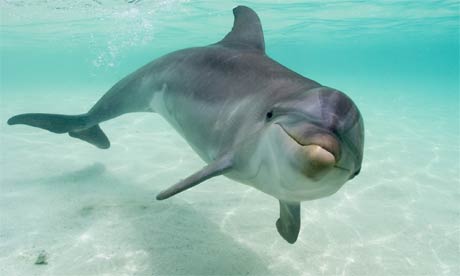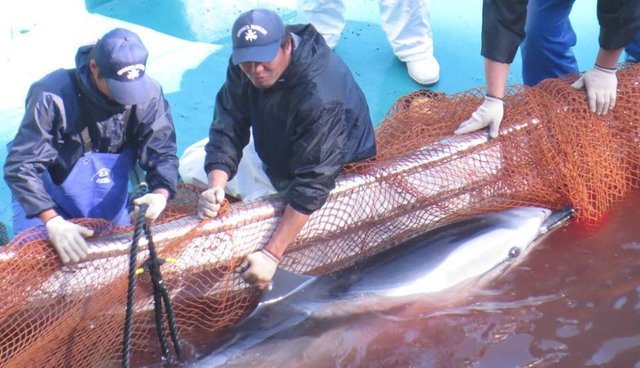Dolphins: Not Endangered but on the radar
For this civic issues post, I will be taking a little different approach. This post will focus on dolphins, an animal that has recently come to my attention. I will especially be focusing on those affected by the Taiji Dolphin Drive Hunt.
Firstly, let’s establish some basic facts about dolphins. There are many different types of dolphins, including bottlenose, spotted, stripped, and river. For the purposes of this post, I will be focusing on the bottlenose dolphin (Tursiops truncates) because it is the most familiar to the average person. There are two types of bottlenose dolphins: common and Indo-Pacific. These dolphins tend to live in warmers waters and prefer temperate or tropical climates. They live in groups, known as pods, of about a dozen. This interaction with other dolphins allows these animal to develop complex social skills that are not common in many other animals. Also, they work in groups to catch their prey consisting of fish. This teamwork is also no very common in the animal kingdom. Even though the population of current dolphins (about 600,000) is not of great concern, recent developments may lead to endangerment of this species in the future.

Bottlenose Dolphin
One of the biggest threats to dolphins is hunting. In Taiji, Japan, there is an annual dolphin hunt. This hunt involves herding dolphins into Taiji Cove, which puts a lot of stress on the animals to begin with, and slaughtering the dolphins or selling them to aquariums. The slaughtered dolphins are used to meat. The hunters of these dolphins do not see anything wrong with their actions and is rather a source of income. They even claim that what they are doing is part of traditions that have been around for thousand of year, but, according to Wikipedia, it only started in 1969.

Dolphin being captured in Taiji Cove
Surprisingly, Taiji is also home to a whale museum. Even though it would be understood that those who work for the museum would be against the killings, they actually do not see a problem with it. One man who works for the museum claimed that “people are thinking too emotionally about the dolphins. They just want to protect them because they are cute and clever.” This shows the obvious disregard for the atrocities being done to these dolphins. Even though, over the years, the number of dolphins killed and captured has dropped, the dolphin hunt is still a relevant issue. An Oscar award winning documentary, The Cove, has brought this issue to people’s attention, much to the dislike of Japan.

Taiji Whale Museum
The protection of the dolphin is of critical importance. Let’s start with the obvious: they are extremely beautiful animals that are simply just nice to look at. They are also extremely smart. Over the years, there have been many reports of dolphins returning things people have dropped into the water, saving people from drowning, and leading people who are lost back to land. They are incredible creatures and it is such a shame that they are being hunted so crucially.
Dolphins, like the polar bears mentioned in my previous post, act as an indicator of the health of the ocean. Because they are a high level predator, meaning they are not prey to many or any animals, finding dead or ill dolphins is a sign of water pollution. Dolphins are also important in keeping disease among other species from spreading. When hunting, dolphins will often prey on old and sick fish because they are the easiest to catch. This keep the disease the fish had from spreading, which benefits the fish species and other inhabitants of the ocean.
Even though Japan is not trying to stop the Taiji Dolphin Drive Hunt, others are. The most infamous group working to protect these dolphins is the Sea Shepard. Volunteers of the Sea Shepard go to Japan during the Taiji hunt and try to stop the killing of these dolphins. They employ “Cove Guardians” to monitor and film the killings in order to make more people award of the situation. Japanese authorities often deny them access to the cove or intervene in other ways. Despite the inability to directly stop the killing, the Sea Shepard still puts great effort into trying to protect the dolphins. However, the Japanese government is responding with laws to protect the hunters, which is making the Sea Shepard’s job even more difficult.
Although dolphins are not yet endangered, they still must be protected, especially in light of horrendous events such as the Taiji Dolphin Drive Hunt. I, for one, love dolphins and think they are among some of the most beautiful creatures on Earth. It saddens and angers me that they are put through such torment and are killed in such awful ways. Is there any other ways that these dolphins could be protected? Should the governments of other countries step in before dolphins are endangered?
The Polar Bear: An Indication of the Declining State of our Earth
In this post, I will be focusing on the polar bear: an animal that has been in the spot light in the environmental scene since I was a child. Although the extinction of the polar bear may not have as many implications for humans as the black rhino (see my previous post), it would be an indication of other environmental issues.
The polar bear, or Ursus maritimus, is native to the Arctic circle and can be found in Northern Canada, Alaska, Northern Russia, and Greenland. This 1,000 pound animal can be up to nine feet long and not too friendly, meaning it is best to come into close proximity to one. Unlike other bears, which are omnivores, the polar bear is a carnivore. This strictly meat-based diet is most likely due to the lack of plant life in the freezing biomes that the polar bear calls home. Also, a meat-based diet allows polar bears to preserve their body fat, which they use to keep themselves warm. These bears spend up to 50% of their time hunting, so it is critical that there are enough prey animals available to sustain its caloric needs. The current population of the polar bear is estimated to be between 22,000-31,000 (Source: WWF).

A polar bear photographed by Steven Morello
Although the polar bear is not considered endangered, according to the World Wildlife Fund (WWF), it is currently classified as vulnerable to endangerment and have a declining population. The main reason for their decline is due to global warming. Global warming (more correctly referred to as global climate change) is due to green house gas admissions that trap warming sun rays from escaping the atmosphere and thus causing the overall temperature of the Earth to increase (Source: Nasa). The raising of the temperature of Earth is especially detrimental for polar bears because it has a major effect of their icy habitats. Melting of Arctic ice makes it more difficult for these bears to find food. As examined in a study conducted near Alaska’s Prudhoe Bay and reported by The New York Times, polar bears have a metabolism 60% greater than thought in the past. This means that with difficulty finding food, they are at much greater risk of death due to starvation. Lack of food also leads to lack of blubber, so they are more vulnerable to the cold as well. It is estimated, according to a Smithsonian article, that two thirds of the polar bear population will die due to melting of Arctic ice by 2050. Not only are these bears dying of starvation and the cold, they are also drowning. Despite being excellent swimmers, raising melting ice and rising water levels means the polar bear must swim for more extended periods of time, which can lead to exhaustion and death. All these factors lead to a declining rate of reproduction and bear cubs dying to malnutrition and starvation according to WWF , which leads to a declining population and feeds into the inability of the polar bear to come out of the vulnerable to endangerment classification.
Climate change is not the only threat to the polar bear. WWF claims that oil spills also greatly affect polar bear health. The oil causes the bears fur to decline in it insulation properties. Also, oil of the bear’s fur may be ingested during grooming is poisonous to polar bears, affecting their liver and kidneys.

Polar bear covered in oil photographed by Alastair Rae
WWF also states that the reduction of polar bear habitat leads to the bears being driven to more human populated area. A face-to-face encounter with a polar bear would certainly not be a pleasant one.
Even if the polar bear is not considered to the economy, the drop in the their population can be indicative of problems for humans. The loss of polar bear habitat indicates that Arctic ice is melting. What is melted ice?: water. The water that comes from the melted ice raises sea levels and disrupted the inhabitants of the ocean. This could lead to problems in the fishing industry. Because the ocean ecosystem would be disrupted, fish would decline in population or move to a different area, making it difficult for fishers to catch fish. This would lead to economic problems including less profit and less jobs. The oil spills affecting the polar bear can also be a danger to human health as well as the economy. Eventually, oil from oil spills will seep into the Earth and make its way into drinking water. This water would be consumed by both people and animals, which would lead to detrimental health affects. The affects on animals would show in the economy because, with animals dying due to tainted water, the meat and dairy industry would take a hard hit.
Despite no immediate danger to humans comes with the possible endangerment of the polar bear, it should not be over looked. The state of the polar bear should be used as a gauge to indicate the state of the Earth and the effects of global climate change and oil spills. Is there any hope left for the polar bear? Is it even possible to reverse the harm green house gas admission has cause these animals and the Earth? A USGS study may bring some hope, but for now, the future of the polar bear is unclear.
